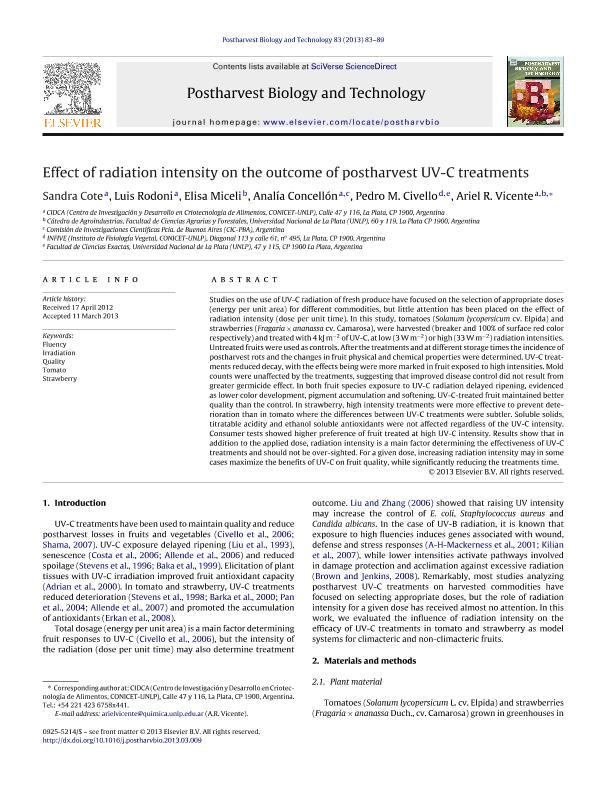Mostrar el registro sencillo del ítem
dc.contributor.author
Cote, Sandra
dc.contributor.author
Rodoni, Luis Maria

dc.contributor.author
Miceli, Elisa

dc.contributor.author
Concellón, Analía

dc.contributor.author
Civello, Pedro Marcos

dc.contributor.author
Vicente, Ariel Roberto

dc.date.available
2019-09-25T17:57:21Z
dc.date.issued
2013-09
dc.identifier.citation
Cote, Sandra; Rodoni, Luis Maria; Miceli, Elisa; Concellón, Analía; Civello, Pedro Marcos; et al.; Effect of radiation intensity on the outcome of postharvest UV-C treatments; Elsevier Science; Postharvest Biology and Technology; 83; 9-2013; 83-89
dc.identifier.issn
0925-5214
dc.identifier.uri
http://hdl.handle.net/11336/84419
dc.description.abstract
Studies on the use of UV-C radiation of fresh produce have focused on the selection of appropriate doses (energy per unit area) for different commodities, but little attention has been placed on the effect of radiation intensity (dose per unit time). In this study, tomatoes (Solanum lycopersicum cv. Elpida) and strawberries (Fragaria×ananassa cv. Camarosa), were harvested (breaker and 100% of surface red color respectively) and treated with 4kJm-2 of UV-C, at low (3Wm-2) or high (33Wm-2) radiation intensities. Untreated fruits were used as controls. After the treatments and at different storage times the incidence of postharvest rots and the changes in fruit physical and chemical properties were determined. UV-C treatments reduced decay, with the effects being were more marked in fruit exposed to high intensities. Mold counts were unaffected by the treatments, suggesting that improved disease control did not result from greater germicide effect. In both fruit species exposure to UV-C radiation delayed ripening, evidenced as lower color development, pigment accumulation and softening. UV-C-treated fruit maintained better quality than the control. In strawberry, high intensity treatments were more effective to prevent deterioration than in tomato where the differences between UV-C treatments were subtler. Soluble solids, titratable acidity and ethanol soluble antioxidants were not affected regardless of the UV-C intensity. Consumer tests showed higher preference of fruit treated at high UV-C intensity. Results show that in addition to the applied dose, radiation intensity is a main factor determining the effectiveness of UV-C treatments and should not be over-sighted. For a given dose, increasing radiation intensity may in some cases maximize the benefits of UV-C on fruit quality, while significantly reducing the treatments time.
dc.format
application/pdf
dc.language.iso
eng
dc.publisher
Elsevier Science

dc.rights
info:eu-repo/semantics/openAccess
dc.rights.uri
https://creativecommons.org/licenses/by-nc-sa/2.5/ar/
dc.subject
Fluency
dc.subject
Irradiation
dc.subject
Quality
dc.subject
Strawberry
dc.subject
Tomato
dc.subject.classification
Horticultura, Viticultura

dc.subject.classification
Agricultura, Silvicultura y Pesca

dc.subject.classification
CIENCIAS AGRÍCOLAS

dc.title
Effect of radiation intensity on the outcome of postharvest UV-C treatments
dc.type
info:eu-repo/semantics/article
dc.type
info:ar-repo/semantics/artículo
dc.type
info:eu-repo/semantics/publishedVersion
dc.date.updated
2019-09-23T13:33:05Z
dc.journal.volume
83
dc.journal.pagination
83-89
dc.journal.pais
Países Bajos

dc.journal.ciudad
Amsterdam
dc.description.fil
Fil: Cote, Sandra. Provincia de Buenos Aires. Gobernación. Comisión de Investigaciones Científicas. Centro de Investigación y Desarrollo en Criotecnología de Alimentos. Consejo Nacional de Investigaciones Científicas y Técnicas. Centro Científico Tecnológico Conicet - La Plata. Centro de Investigación y Desarrollo en Criotecnología de Alimentos. Universidad Nacional de la Plata. Facultad de Ciencias Exactas. Centro de Investigación y Desarrollo en Criotecnología de Alimentos; Argentina
dc.description.fil
Fil: Rodoni, Luis Maria. Provincia de Buenos Aires. Gobernación. Comisión de Investigaciones Científicas. Centro de Investigación y Desarrollo en Criotecnología de Alimentos. Consejo Nacional de Investigaciones Científicas y Técnicas. Centro Científico Tecnológico Conicet - La Plata. Centro de Investigación y Desarrollo en Criotecnología de Alimentos. Universidad Nacional de la Plata. Facultad de Ciencias Exactas. Centro de Investigación y Desarrollo en Criotecnología de Alimentos; Argentina
dc.description.fil
Fil: Miceli, Elisa. Universidad Nacional de La Plata. Facultad de Ciencias Agrarias y Forestales; Argentina
dc.description.fil
Fil: Concellón, Analía. Provincia de Buenos Aires. Gobernación. Comisión de Investigaciones Científicas. Centro de Investigación y Desarrollo en Criotecnología de Alimentos. Consejo Nacional de Investigaciones Científicas y Técnicas. Centro Científico Tecnológico Conicet - La Plata. Centro de Investigación y Desarrollo en Criotecnología de Alimentos. Universidad Nacional de la Plata. Facultad de Ciencias Exactas. Centro de Investigación y Desarrollo en Criotecnología de Alimentos; Argentina. Provincia de Buenos Aires. Gobernación. Comisión de Investigaciones Científicas; Argentina
dc.description.fil
Fil: Civello, Pedro Marcos. Consejo Nacional de Investigaciones Científicas y Técnicas. Centro Científico Tecnológico Conicet - La Plata. Instituto de Fisiología Vegetal. Universidad Nacional de La Plata. Facultad de Ciencias Naturales y Museo. Instituto de Fisiología Vegetal; Argentina. Universidad Nacional de La Plata. Facultad de Ciencias Exactas; Argentina
dc.description.fil
Fil: Vicente, Ariel Roberto. Provincia de Buenos Aires. Gobernación. Comisión de Investigaciones Científicas. Centro de Investigación y Desarrollo en Criotecnología de Alimentos. Consejo Nacional de Investigaciones Científicas y Técnicas. Centro Científico Tecnológico Conicet - La Plata. Centro de Investigación y Desarrollo en Criotecnología de Alimentos. Universidad Nacional de la Plata. Facultad de Ciencias Exactas. Centro de Investigación y Desarrollo en Criotecnología de Alimentos; Argentina. Universidad Nacional de La Plata. Facultad de Ciencias Agrarias y Forestales; Argentina
dc.journal.title
Postharvest Biology and Technology

dc.relation.alternativeid
info:eu-repo/semantics/altIdentifier/doi/http://dx.doi.org/10.1016/j.postharvbio.2013.03.009
dc.relation.alternativeid
info:eu-repo/semantics/altIdentifier/url/https://www.sciencedirect.com/science/article/pii/S0925521413000835
Archivos asociados
